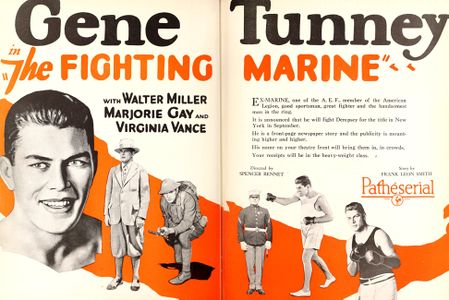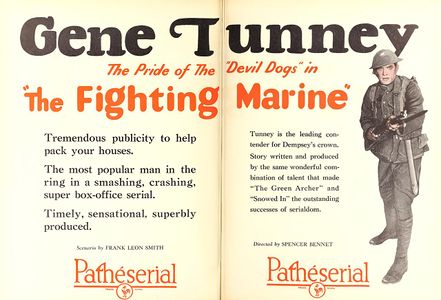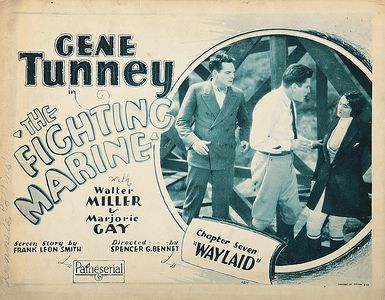The Fighting Marine (lost Gene Tunney drama film serial; 1926)
The Fighting Marine is a 1926 drama film serial produced by Pathé Exchange. Directed by Spencer Gordon Bennet, it was released in ten parts between 12th September to 14th November 1926, and as a feature film on 24th September 1926. It starred future boxing World Heavyweight Champion Gene Tunney as Dick Farrington, a reporter who must ensure that Lady Chatfield stays within the confounds of mining properties so she can inherit them.
Background
Prior to filming The Fighting Marine, Gene Tunney had previously served the United States in the First World War as part of the Marine Corps.[1] This would also enhance his boxing career, as he competed against American and French soldiers on-route to winning the American Expeditionary Forces’ light heavyweight championship.[1] Post-tour, he turned professional, where his military background and success boxing against other armed forces would lead to him being nicknamed "The Fighting Marine".[2][1] After rising through the ranks of the light heavyweight division, Tunney began making challenges for Jack Dempsey's World Heavyweight Championship.[1] This fight would be scheduled on 23rd September 1926.[3][4][1] However, Tunney also accepted that he needed significantly more media coverage in order to gain mainstream appeal.[5] Therefore, he followed Dempsey into starring in films, agreeing a deal with Pathé Exchange to star in The Fighting Marine as Dick Farrington.[6][5][3] Aside from giving him ample time-off from the ring, Tunney would also be paid $24,000, in addition to a quarter of the film's revenue.[3]
Based on a summary from The American Film Institute, Tunney starred as reporter Dick Farrington, who responds to a newspaper advertisement that sought a champion and guardian for Lady Chatfield, played by Marjorie Gay.[2][6] Lady Chatfield received a will stating that she could inherit mining properties situated across the American West, providing she exclusively stays within its confounds for the next six months.[2] If she fails to conform, the mine superintendent and the miners will gain the land instead.[2] The mine superintendent is the main antagonist of the serial, plotting several schemes to force Lady Chatfield to leave.[2] However, Farrington ultimately foils each scheme, even escaping being entombed and caught out by a collapsing tower, enabling Lady Chatfield to fulfil the will's terms and inherit the properties.[2][3] The serial concludes with Farrington and Lady Chatfield ending up in a romantic relationship.[2]
Tunney would not only showcase his boxing skills, but also show him on horseback.[3] Pathé planned to release the film in ten parts from September to November 1926, with the first released 12 days before the fight on 12th September to boost interest for the upcoming bout.[6][3][5] To ensure its success, they were banking on Tunney winning his upcoming fight with Dempsey.[3] Ultimately, Tunney dominated the fight, winning the World Heavyweight Championship in the process and securing the film's survival at the box office.[1][3][4] The Fighting Marine was critically acclaimed, and would later be released as a feature on 24th September 1926 in the United States, and as a serial in Denmark starting from 22nd November 1926.[3][6] Despite the film's success, Tunney, who now had obligations as a world champion, decided not to appear in future films.[3][2]
Availability
Ultimately, The Fighting Marine has been declared by Silent Era to be a missing film, although it is unclear as to how it disappeared.[6] No footage of the film has emerged, although a photo depicting Farrington and the supporting characters confronting the superintendent has survived.[6] Further photos can be found in surviving film posters.
Gallery
Images
See Also
- Barbara Buttrick vs Gloria Adams (lost radio coverage of boxing match; 1959)
- Bill Lewis vs Freddie Baxter and Archie Sexton vs Laurie Raiteri (lost television coverage of boxing matches; 1933)
- Corbett and Courtney Before the Kinetograph (partially found early boxing film; 1894)
- England vs Ireland (lost television coverage of boxing matches; 1937)
- Exhibition Boxing Bouts (lost early television coverage of boxing matches; 1931-1932)
- Gene Tunney vs Jack Dempsey (partially lost radio coverage of "The Long Count Fight"; 1927)
- Georges Carpentier vs Ted "Kid" Lewis (lost radio coverage of boxing match; 1922)
- Heavyweight Champ (lost SEGA arcade boxing game; 1976)
- Jack Dempsey vs Billy Miske (lost radio report of boxing match; 1920)
- Jack Dempsey vs Georges Carpentier (lost radio coverage of boxing match; 1921)
- Jo-Ann Hagen vs Barbara Buttrick (lost radio and television coverage of boxing match; 1954)
- Johnny Ray vs Johnny Dundee (lost radio coverage of boxing match; 1921)
- Leonard-Cushing Fight (partially found early boxing film; 1894)
- Rocky (lost deleted scenes of boxing drama film; 1976)
- Uncle Slam and Uncle Slam Vice Squad (lost iOS presidential boxing games; 2011)
External Link
References
- ↑ 1.0 1.1 1.2 1.3 1.4 1.5 The Fight City detailing the career of Tunney, including his time in the Marines. Retrieved 1st Jan '23
- ↑ 2.0 2.1 2.2 2.3 2.4 2.5 2.6 2.7 American Film Institute summarising the film's plot. Retrieved 1st Jan '23
- ↑ 3.0 3.1 3.2 3.3 3.4 3.5 3.6 3.7 3.8 3.9 Great Movie Serials summarising The Fighting Marine's success being based around the upcoming Tunney-Dempsey bout's outcome, and the perks Tunney receiving for starring in it. Retrieved 1st Jan '23
- ↑ 4.0 4.1 BoxRec detailing Tunney's fight record. Retrieved 1st Jan '23
- ↑ 5.0 5.1 5.2 The Boxing Film noting The Fighting Marine was used to boost interest in the upcoming Dempsey-Tunney fight. Retrieved 1st Jan '23
- ↑ 6.0 6.1 6.2 6.3 6.4 6.5 Silent Era summarising the film's cast, its ten parts, and noting it is presumed lost. Retrieved 1st Jan '23




